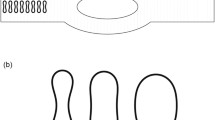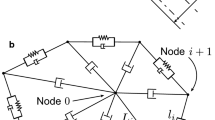Abstract
Nonproportional RBC distribution is an important characteristic in microvascular networks, which can result in heterogeneity of oxygen supply that may cause ischemic death in severe cases. In this paper, we perform three-dimensional numerical simulations of a large number of RBCs in a microvascular network, by using a hybrid method of smoothed dissipative particle dynamic and immersed boundary method. The distribution of multiple RBCs in a T-bifurcation is first simulated as a validation study, and a reasonable agreement is observed both qualitatively and quantitatively on the RBC flux between our results and the previously published numerical and empirical results. Next, the distribution of a large number of RBCs in a microvascular network is investigated, including the effects of cell deformability, aggregation and tube hematocrit. The simulation results indicate that decreased deformability and increased aggregation strength have a similar effect on the RBC distribution: the large RBC flux becomes larger, but the small becomes smaller. A high hematocrit also causes a similar phenomenon that the RBCs are more apt to flow into a high RBC-flux branch, because they are arranged compactly into a rouleaux and difficultly broken up at a high hematocrit. These results imply that lower cell deformability, stronger aggregation or higher tube hematocrit would be conducive to the phase separation of hematocrit and plasma skimming processes in microcirculation.









Similar content being viewed by others
References
Balogh P, Bagchi P (2017a) A computational approach to modeling cellular-scale blood flow in complex geometry. J Comput Phys 334:280–307
Balogh P, Bagchi P (2017b) Direct numerical simulation of cellular-scale blood flow in 3D microvascular networks. Biophys J 113:2815–2826
Balogh P, Bagchi P (2018) Analysis of red blood cell partitioning at bifurcations in simulated microvascular networks. Phys Fluids 30:051902
Barber JO, Alberding JP, Restrepo JM, Secomb TW (2008) Simulated two-dimensional red blood cell motion, deformation, and partitioning in microvessel bifurcations. Ann Biomed Eng 36:1690–1698
Barber JO, Restrepo JM, Secomb TW (2011) Simulated red blood cell motion in microvessel bifurcations: effects of cell–cell interactions on cell partitioning. Cardiovasc Eng Technol 2:349–360
Bian X, Litvinov S, Qian R, Ellero M, Adams NA (2012) Multiscale modeling of particle in suspension with smoothed dissipative particle dynamics. Phys Fluids 24:012002
Catita J, López-Luppo M, Ramos D, Nacher V, Navarro M, Carretero A, Sánchez-Chardi A, Mendes-Jorge L, Rodriguez-Baeza A, Ruberte J (2015) Imaging of cellular aging in human retinal blood vessels. Exp Eye Res 135:14–25
Chien S, Tvetenstrand CD, Epstein MA, Schmid-Schönbein GW (1985) Model studies on distributions of blood cells at microvascular bifurcations. Am J Physiol 248:568–576
Chung B, Johnson PC, Popel AS (2007) Application of Chimera grid to modelling cell motion and aggregation in a narrow tube. Int J Numer Methods Fluids 53:105–128
Ellero M, Español P (2018) Everything you always wanted to know about SDPD (but were afraid to ask). Appl Math Mech Engl Ed 39:103–124
Español P, Revenga M (2003) Smoothed dissipative particle dynamics. Phys Rev E 67:026705
Fedosov DA, Caswell B, Karniadakis GE (2010a) A multiscale red blood cell model with accurate mechanics, rheology, and dynamics. Biophys J 98:2215–2225
Fedosov DA, Caswell B, Karniadakis GE (2010b) Systematic coarse-graining of spectrin-level red blood cell models. Comput Methods Appl Mech Eng 199:1937–1948
Fenton BM, Carr RT, Cokelet GR (1985) Nonuniform red cell distribution in 20 to 100 micrometers bifurcations. Microvasc Res 29:103–126
Francis C, Frederic L, Cline F, Steffen P, Valerie LC (2006) A novel three-dimensional computer-assisted method for a quantitative study of microvascular networks of the human cerebral cortex. Microcirculation 13:1–18
Freund JB (2007) Leukocyte margination in a model microvessel. Phys Fluids 19:023301
Freund JB (2014) Numerical simulation of flowing blood cells. Ann Rev Fluid Mech 46:67–95
Gompper G, Fedosov DA (2016) Modeling microcirculatory blood flow: current state and future perspectives. WIREs Syst Biol Med 8:157–168
Groot RD, Warren PB (1997) Dissipative particle dynamics: bridging the gap between atomistic and mesoscopic simulation. J Chem Phys 107:4423–4435
Hochmuth RM (1987) Erythrocyte membrane elasticity and viscosity. Ann Rev Physiol 49:209–219
Hu J, Cao Y, Wu T, Li D, Lu H (2014) High-resolution three-dimensional visualization of the rat spinal cord microvasculature by synchrotron radiation micro-CT. Med Phys 41:101904
Hyakutake T, Nagai S (2015) Numerical simulation of red blood cell distributions in three-dimensional microvascular bifurcations. Microvasc Res 97:115–123
Hyakutake T, Matsumoto T, Yanase S (2006) Lattice Boltzmann simulation of blood cell behavior at microvascular bifurcations. Math Comput Simul 72:134–140
Hyakutake T, Tominaga S, Matsumoto T, Yanase S (2008) Numerical study on flows of red blood cells with liposome-encapsulated hemoglobin at microvascular bifurcation. J Biomech Eng 130:011014
Kaliviotis E, Sherwood JM, Balabani S (2017) Partitioning of red blood cell aggregates in bifurcating microscale flows. Sci Rep 7:44563
Lei H, Fedosov DA, Karniadakis GE (2011) Time-dependent and outflow boundary conditions for dissipative particle dynamics. J Comput Phys 230:3765–3779
Li X, Popel AS, Karniadakis GE (2012) Blood-plasma separation in Y-shaped bifurcating microfluidic channels: a dissipative particle dynamics simulation study. Phys Biol 9(2):026010
Liu YL, Liu WK (2006) Rheology of red blood cell aggregation by computer simulation. J Comput Phys 220:139–154
Liu Y, Zhang L, Wang X, Liu W (2004) Coupling of Navier–Stokes equations with protein molecular dynamics and its application to hemodynamics. Int J Numer Methods Fluids 46:1237–1252
Liu MB, Shao JR, Chang JZ (2012) On the treatment of solid boundary in smoothed particle hydrodynamics. Sci China Technol Sci 55:244–254
Lykov K, Li X, Lei H, Pivkin IV, Karniadakis GE (2015) Inflow/outflow boundary conditions for particle-based blood flow simulations: application to arterial bifurcations and trees. PLoS Comput Biol 11:e1004410
Maeda N (1996) Erythrocyte rheology in microcirculation. Jpn J Physiol 46:1–14
Noguchi H, Gompper G (2005) Vesicle dynamics in shear and capillary flows. J Phys 17:S3439–S3444
Peskin CS (2002) The immersed boundary method. Acta Numer 11:1–39
Pivkin IV, Karniadakis GE (2008) Accurate coarse-grained modeling of red blood cells. Phys Rev Lett 101:118105
Popel AS, Johnson PC (2005) Microcirculation and hemorheology. Ann Rev Fluid Mech 37:43–69
Pries AR, Secomb TW (2003) Rheology of the microcirculation. Clin Hemorheol Microcirc 29:143–148
Pries AR, Secomb TW (2005) Microvascular blood viscosity in vivo and the endothelial surface layer. Am J Physiol 289:2657–2664
Pries AR, Ley K, Claassen M, Gaehtgens P (1989) Red cell distribution at microvascular bifurcations. Microvasc Res 38:81–101
Pries AR, Secomb TW, Gaehtgens P, Gross JF (1990) Blood flow in microvascular networks: experiments and simulation. Circ Res 67:826–834
Schmid-Schönbein GW, Skalak R, Usami S, Chien S (1980) Cell distribution in capillary networks. Microvasc Res 19:18–44
Secomb TW (2017) Blood flow in the microcirculation. Ann Rev Fluid Mech 49:443–461
Secomb TW, Styp-Rekowska B, Pries AR (2007) Two-dimensional simulation of red blood cell deformation and lateral migration in microvessels. Ann Biomed Eng 35:755–765
Secomb TW, Barber JO, Alberding JP, Restrepo JM (2008) Motion of red blood cells in microvessels and bifurcations: computational simulations. Biorheology 45:35–36
Skorczewski T, Erickson LC, Fogelson AL (2013) Platelet motion near a vessel wall or thrombus surface in two-dimensional whole blood simulations. Biophys J 104:1764–1772
Tian T, Zhai Q, Zhang R (2018) A new modified weak Galerkin finite element scheme for solving the stationary stokes equations. J Comput Appl Math 329:268–279
Vahidkhah K, Diamond S, Bagchi P (2014) Platelet dynamics in three-dimensional simulation of whole blood. Biophys J 106:2529–2540
Vázquez-Quesada A, Ellero M, Español P (2009) Smoothed particle hydrodynamic model for viscoelastic fluids with thermal fluctuations. J Chem Phys 130:034901
Wang T, Rongin U, Xing ZX (2016) A micro-scale simulation of red blood cell passage through symmetric and asymmetric bifurcated vessels. Sci Rep 6:20262
Xiao LL, Liu Y, Chen S, Fu BM (2017) Effects of flowing RBCs on adhesion of a circulating tumor cell in microvessels. Biomech Model Mechanobiol 16:1–14
Xiong WJ, Zhang J (2012) Two-dimensional lattice Boltzmann study of red blood cell motion through microvascular bifurcation: cell deformability and suspending viscosity effects. Biomech Mod Mechanobiol 11:575–583
Xu YQ, Tian FB, Li HJ, Deng YL (2012) Red blood cell partitioning and blood flux redistribution in microvascular bifurcation. Theor Appl Mech Lett 2:024001
Yang S, Undar A, Zahn JD (2006) A microfluidic device for continuous, real time blood plasma separation. Lab Chip 6:871–880
Ye T, Peng LN (2019) Motion, deformation and aggregation of multiple red blood cells in three-dimensional microvessel bifurcations. Phys Fluids 31:021903
Ye T, Phan-Thien N, Khoo BC, Lim CT (2014) A file of red blood cells in tube flow: a three-dimensional numerical study. J Appl Phys 116:124703
Ye T, Phan-Thien N, Lim CT (2016) Particle-based simulations of red blood cells—a review. J Biomech 49:2255–2266
Ye T, Phan-Thien N, Lim CT, Peng LN, Shi HX (2017a) Hybrid smoothed dissipative particle dynamics and immersed boundary method for simulation of red blood cells in flows. Phys Rev E 95:063314
Ye T, Shi HX, Peng LN, Li Y (2017b) Numerical studies of a red blood cell in rectangular microchannels. J Appl Phys 122:084701
Ye T, Phan-Thien N, Khoo BC, Li Y (2018a) Flow patterns and red blood cell dynamics in a U-bend. J Appl Phys 124:124701
Ye T, Shi HX, Phan-Thien N, Lim CT, Li Y (2018b) Relationship between transit time and mechanical properties of a cell through a stenosed microchannel. Soft Matter 14:533–545
Ye T, Pan DY, Huang C, Liu MB (2019) Smoothed particle hydrodynamics (SPH) for complex fluid flows: recent developments in methodology and applications. Phys Fluids 31:011301
Yin XW, Thomas T, Zhang J (2013) Multiple red blood cell flows through microvascular bifurcations: cell free layer, cell trajectory, and hematocrit separation. Microvasc Res 89:47–56
Zhang J (2011a) Effect of suspending viscosity on red blood cell dynamics and blood flows in microvessels. Microcirculation 18:562–573
Zhang J (2011b) Lattice Boltzmann method for microfluidics: models and applications. Microfluid Nanofluid 10:1–28
Zhang J, Johnson PC, Popel AS (2008) Red blood cell aggregation and dissociation in shear flows simulated by lattice Boltzmann method. J Biomech 41:47–55
Zhang J, Johnson PC, Popel AS (2009) Effects of erythrocyte deformability and aggregation on the cell free layer and apparent viscosity of microscopic blood flows. Microvasc Res 77:265–272
Acknowledgements
The authors gratefully acknowledge the financial support from the National Natural Science Foundation of China under Project No. 11502094.
Author information
Authors and Affiliations
Corresponding author
Additional information
Publisher's Note
Springer Nature remains neutral with regard to jurisdictional claims in published maps and institutional affiliations.
Electronic supplementary material
Below is the link to the electronic supplementary material.
Supplementary material 3 (avi 15288 KB)
Supplementary material 4 (avi 17467 KB)
Supplementary material 5 (avi 15986 KB)
Supplementary material 6 (avi 16890 KB)
Supplementary material 7 (avi 14407 KB)
Rights and permissions
About this article
Cite this article
Ye, T., Peng, L. & Li, G. Red blood cell distribution in a microvascular network with successive bifurcations. Biomech Model Mechanobiol 18, 1821–1835 (2019). https://doi.org/10.1007/s10237-019-01179-5
Received:
Accepted:
Published:
Issue Date:
DOI: https://doi.org/10.1007/s10237-019-01179-5




